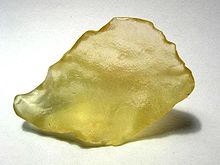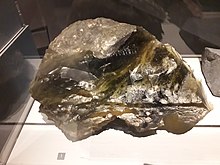

Libyan desert glass or Great Sand Sea glass is an impactite, made mostly of lechatelierite, found in areas in the eastern Sahara, in the deserts of eastern Libya and western Egypt. Fragments of desert glass can be found over areas of tens of square kilometers. Like obsidian, it was knapped and used to make tools during the Pleistocene.
Geologic origin

The origin of desert glass is uncertain. Meteoritic origins have long been considered possible, and recent research links the glass to impact features, such as zircon breakdown, vaporized quartz and meteoritic metals, and to an impact crater. Some geologists associate the glass with radiative melting from meteoric large aerial bursts, making it analogous to trinitite created from sand exposed to the thermal radiation of a nuclear explosion. Libyan Desert glass has been dated as having formed about 29 million years ago.
Analysis of samples with the electron backscatter diffraction (EBSD) technique revealed zircon crystal structures that form only when reidite melts at very high temperatures and is then converted to zircon. Reidite has been found only at meteorite impact sites, where it was formed at the very high pressures of impact. Airbursts never yield this type of mineral transformation.
See also
- Atacama desert glass – Desert glass found in the Atacama Desert
- Darwin glass – Natural desert glass found in Tasmania
- Edeowie glass – Natural glass found in South Australia
- Hypatia (stone) – Candidate for the first comet nucleus
- Kebira Crater – Circular feature in the Sahara
- Tektite – Gravel-sized glass beads formed from meteorite impacts
- Tunguska event – 1908 meteor air burst explosion in Siberia
References

- "Libyan Desert Glass". mindat.org. Retrieved 12 July 2020.
- "Desert Glass: An Enigma". Saudi Aramco World.
- Jan Kramers; David Block; Marco Andreoli (2013). "First ever evidence of a comet striking Earth". Wits University. Archived from the original on 2013-10-10.
- Kramers, J.D et al (2013): Unique chemistry of a diamond-bearing pebble from the Libyan Desert Glass strewnfield, SW Egypt: Evidence for a shocked comet fragment. Earth and Planetary Science Letters 382, 21-31 doi:10.1016/j.epsl.2013.09.003
- B. Kleinmann (1968): The breakdown of zircon observed in the Libyan desert glass as evidence of its impact origin. Earth and Planetary Science Letters 5, 497-501. doi:10.1016/S0012-821X(68)80085-8
- Weeks, R. (1984): Libyan Desert glass: A review. Journal of Non-Crystalline Solids, 67, 593-619. doi:10.1016/0022-3093(84)90177-7
- Seebaugh, W. R. & Strauss, A. M. (1984): Libyan Desert Glass: Remnants of an Impact Melt Sheet. LUNAR AND PLANETARY SCIENCE XV, 744-745. Bibcode:1984LPI....15..744S
- Barbara Kleinmann, Peter Horn and Falko Langenhorst (2001): Evidence for shock metamorphism in sandstones from the Libyan Desert Glass strewn field. Meteoritics & Planetary Science 36, 1277-1282 doi:10.1111/j.1945-5100.2001.tb01960.x
- Giovanni Pratesi, Cecilia Viti, Curzio Cipriani and Marcello Mellini (2002): Silicate-silicate liquid immiscibility and graphite ribbons in Libyan desert glass. Geochimica et Cosmochimica Acta 66, 903-911.doi:10.1016/S0016-7037(01)00820-1
- Greshake, Ansgar; Koeberl, Christian; Fritz, Jörg; Reimold, W. Uwe (2010). "Brownish inclusions and dark streaks in Libyan Desert Glass: Evidence for high-temperature melting of the target rock". Meteoritics & Planetary Science. 45 (6): 973–989. doi:10.1111/j.1945-5100.2010.01283.x. S2CID 128920720.
- ^ Cavosie, Aaron J.; Koeberl, Christian (1 July 2019). "Overestimation of threat from 100 Mt–class airbursts? High-pressure evidence from zircon in Libyan Desert Glass". Geology. 47 (7): 609–612. Bibcode:2019Geo....47..609C. doi:10.1130/G45974.1. S2CID 155125330.
- "Libyan desert glass mystery solved". cosmosmagazine.com. 23 May 2019. Retrieved 2021-10-21.
- DE MICHELE, V (1998). "The "Libyan Desert Glass" scarab in Tutankhamen's pectoral". Sahara (Segrate) (10): 107–109. ISSN 1120-5679.
- "Tut's gem hints at space impact". 2006-07-19. Retrieved 2024-05-29.
Literature
- V. de Michele (ed.): Proceedings of the Silica '96 Meeting on Libyan Desert Glass and related desert events, Bologna, 1997 Contents
- P.A. Clayton / L.J. Spencer: Silica Glass from the Libyan Desert, Vortrag vom 09.11.1933 online